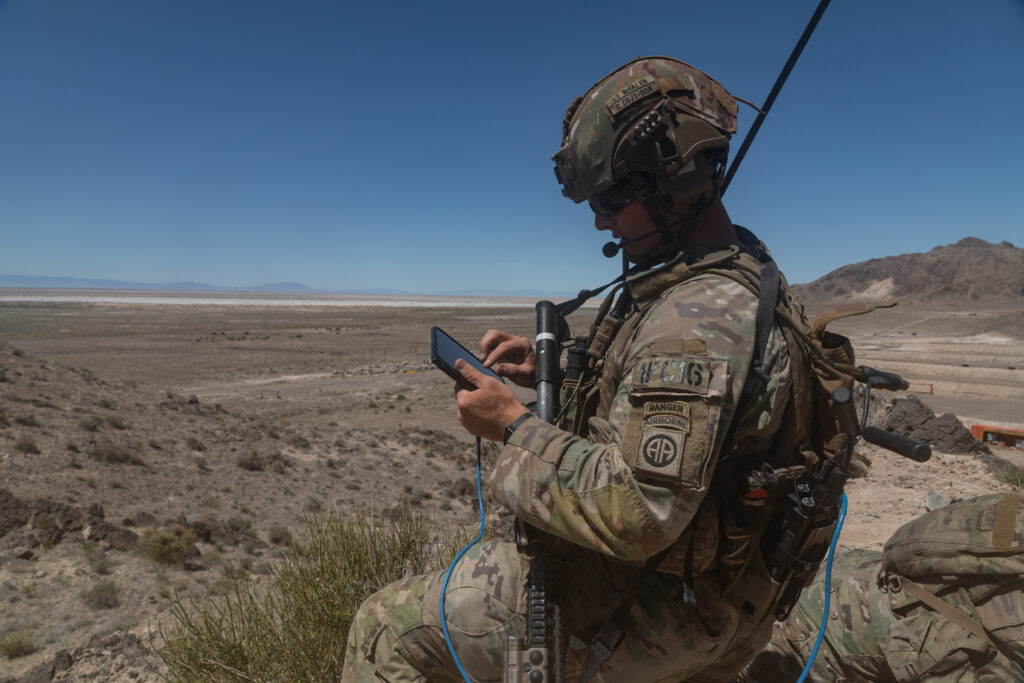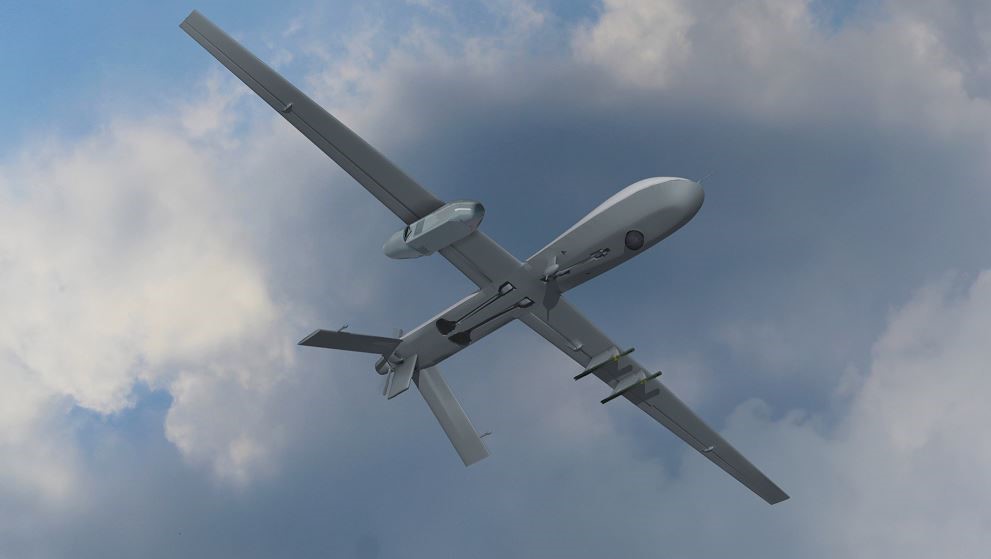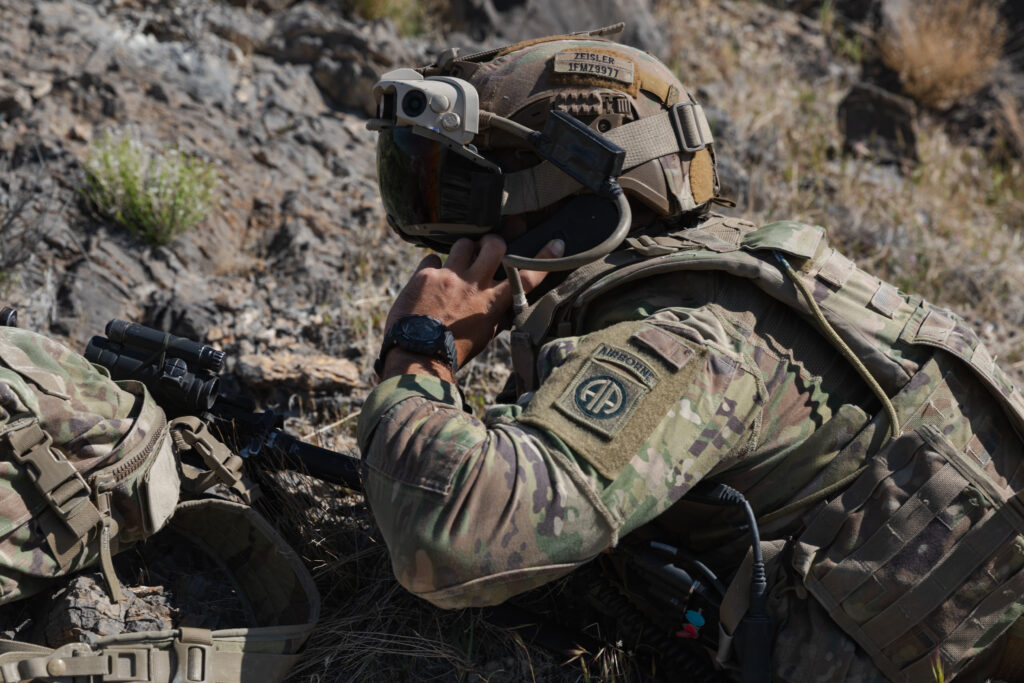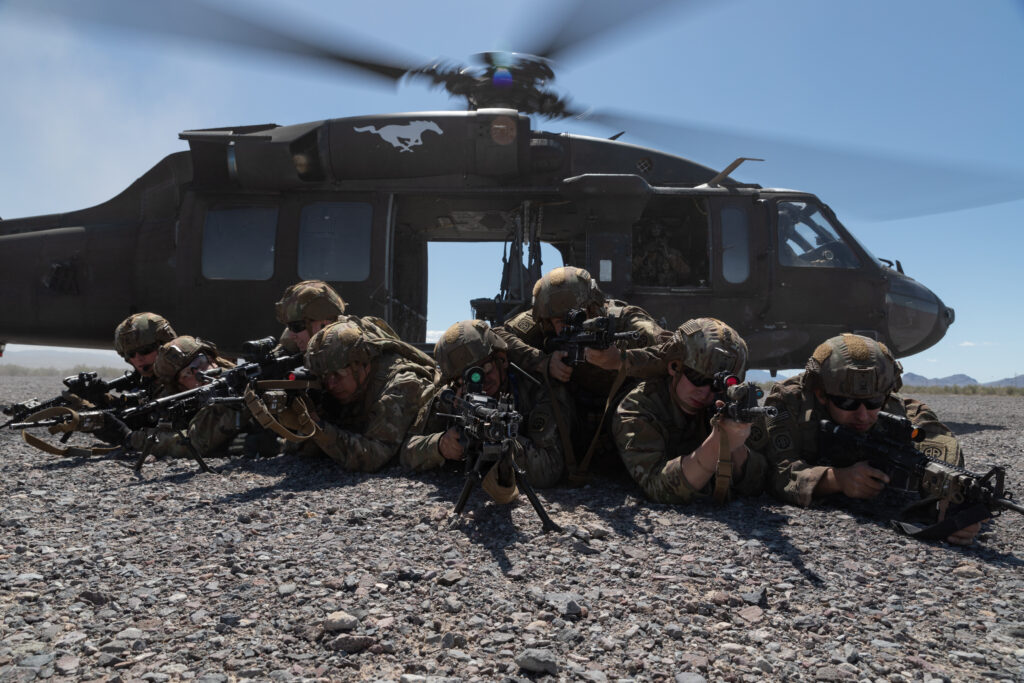
An 18th Airborne soldier works a tablet during exercise EDGE21.
WASHINGTON: A recent Army aviation exercise called EDGE21 was a two-week workout for key technologies ahead of the service’s flagship Project Convergence wargames, generals told reporters this morning. The technologies field-tested at Dugway Proving Grounds in Yuma ranged from jamming pods to infantry goggles to drone controls — all made possible by a prototype Modular Open Systems Architecture, the invisible, digital backbone of the Army’s future air fleet.
MOSA is the Army’s emerging set of common standards and interfaces for aircraft electronics. (There’s an even more nascent standard emerging to link air and ground). While MOSA will come into full effect on the Army’s Future Vertical Lift aircraft, early versions are being retrofitted on existing aircraft, notably on the Army version of the Predator drone, the MQ-1C Grey Eagle.
MOSA enables aircraft to “rapidly… plug and play” a host of upgrades, from jamming pods to munitions, without the usual laborious modification process, explained Maj. Gen. David Francis, commander of the Army Aviation Center of Excellence. That kind of flexibility and adaptability, he said, is key to keeping up with high-tech adversaries in future multi-domain operations across land, air, sea, space, and cyberspace.
“I wouldn’t be surprised if some of our pods that we’re working on are able to get out to the force years sooner because of [MOSA],” said Maj. Gen. Walter Rugen, Army Futures Command’s director for Future Vertical Lift.

Lockheed Martin’s Silent Crow cyber/electronic warfare pod on an Army MQ-1C Grey Eagle drone. Silent Crow is the basis for MFEW-Air-Large (Lockheed illustration)
Jamming Pods
A critical case in point is a pair of new jamming pods integrated on the MOSA-equipped Grey Eagles. One pod came from the Army’s airborne electronic warfare program of record, MFEW-Air, which is now running “months and months” ahead of schedule, Rugen told reporters. The other came from a program too sensitive to name in public, but, he said, “we were very happy with what we saw.”
The Army had neglected long-range electronic warfare since the Cold War, especially amidst the urgency for short-range jamming of roadside bombs in Afghanistan and Iraq. But EW is a major strength of Russia and China, and a critical weakness for a US military increasingly reliant on radio networks.
Electronic warfare systems “had a much larger role [in EDGE21] than what we’ve seen in the past,” Rugen said, jamming Air Force emitters simulating enemy transmissions. The bad guys didn’t try to jam back in this exercise, but they will in Project Convergence.
While he can’t divulge many details about electronic warfare, Rugen said, “we’re probably going to raise the bar going into PC 21, because of the number of successes we saw out there at Dugway.”

A soldier wearing the Microsoft IVAS goggles (Integrated Visual Augmentation System) during exercise EDGE21.
Infantry Goggles
MOSA also helped link 82nd Airborne soldiers aboard helicopters to their division command post 100 kilometers (62 miles) away, Rugen said. The soldiers were conducting a classic airborne mission, a heliborne air assault on a remote target, while wearing a brand-new technology, Microsoft’s Integrated Visual Augmentation System. The IVAS goggles use augmented reality to project a wide range of data on the wearer’s field of vision, from cross-hairs showing where your gun is aimed, to friendly positions, to live feeds from drones.
Connectivity is the Achilles’ heel of such networked systems, but in EDGE21, the lieutenant leading the air assault platoon was able to stay connected “seamlessly” as he moved on and off the Black Hawk (which was equipped with its own local wifi network). The infantry passengers in the back of the aircraft were able to share data with the aircrew in flight (who used tablets, not goggles). The unit make adjustments to their plan en route based on the latest intelligence – and keep the division command post (the TAC) informed while they were doing it.
Data flowed back and forth between different systems, like the frontline WINTAK and the command post’s CPCE, and different levels of classification, from top secret to secure-but-unclassified. Target detections from highly classified “strategic ISR assets” (i.e. spy satellites) flowed swiftly to systems that could use it, from artillery batteries and jamming pods to the infantry platoon leader.
Instead of providing bandwidth-hogging full motion video, however, the Army has simplified target reports to “chipsets,” basically a picture of the target with its coordinates. That streamlined nugget of data is much easier to transmit to frontline soldiers at the fraying edge of the Army’s tactical network.
The 82nd will conducted a similar network-enabled air assault in Project Convergence, the Army has said.

Soldiers conduct an air assault out of a UH-60 Black Hawk during exercise EDGE21.
Drone & Helicopters
The ground troops could also use MOSA-enabled connections to take over nearby drones and task them for reconnaissance missions. Known as the Scalable Control Interface, the system turns the standard Android/Windows Tactical Assault Kit software on infantry leaders’ handheld devices into a universal drone controller.
“Basically, this is the ability for anyone on the battlefield with this ATAK or WINTAK device [to] grab control of every unmanned system we had out there,” Rugen said. (Presumably, in a future network, some kind of artificial intelligence would rapidly adjudicate priorities in case of competing claims to the same drone). The 82nd platoon leader, for instance, could take over everything from Air Launched Effects mini-drones to a nearly-two-ton Grey Eagle.
In Project Convergence, the Army will ramp things up by using the same Scalable Control Interface to let soldiers control an UH-60 Black Hawk helicopter conducting an emergency supply run. The remote-controlled chopper –a DARPA-Sikorsky project called ALIAS – will have a human safety pilot aboard just in case, but it’ll fly entirely on its own, obedient to directions from the ground.
Project Convergence will also include new aviation technologies not tried out at EDGE 21, however. That includes two new weapons systems that will eventually go on the Army’s new scout helicopter, the Future Attack Reconnaissance Aircraft. One is a relatively straightforward 20 mm cannon. The other is a kind of lethal USB port known as a Modular Effects Launcher, whose slots are compatible with both weapons systems – rockets, Hellfire missiles, JAGM, Spike – and electronics – like a radar or a jamming pod.
“We will be shaking that out in PC21,” Rugen said. “It’s a further advancement of this whole open system approach where we want commanders to have a flexibility that we’ve never achieved before.”
In a ‘world first,’ DARPA project demonstrates AI dogfighting in real jet
“The potential for machine learning in aviation, whether military or civil, is enormous,” said Air Force Col. James Valpiani. “And these fundamental questions of how do we do it, how do we do it safely, how do we train them, are the questions that we are trying to get after.”


























